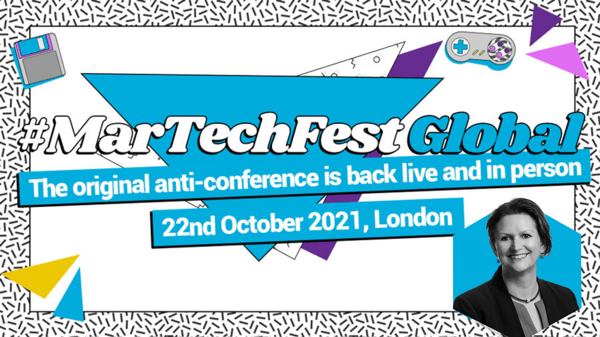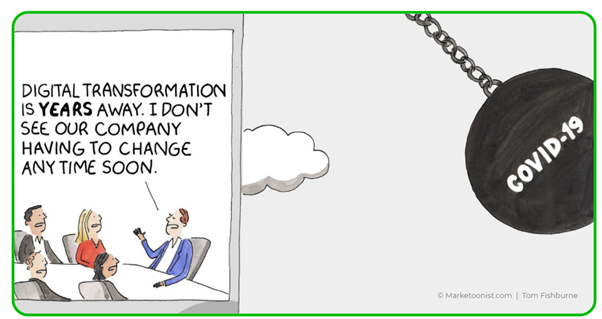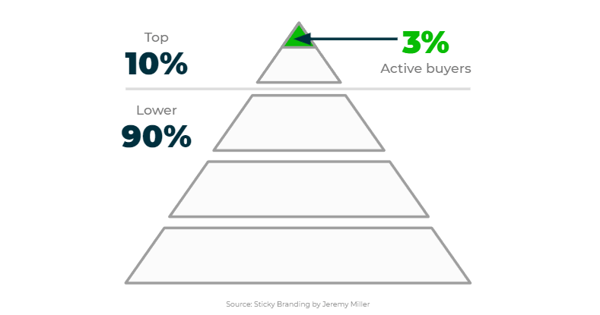Not two, not three, not four, but FIVE digital selling insights popped out, fully-formed, from the brain of Christine Bailey and her PassFort team at this year's #MarTechFest Global.

But don't worry if you missed it, because we're giving you a run-down of the best bits, right now. Especially for you, the person reading this. You're welcome.
When marketers used to think of digital transformation, it seemed like something that was going to happen sometime in the future. Like self driving cars, or Amazon's fulfilment wellness war drones. Or Facebook overtaking your ocular nerves. But then a little thing called COVID came along.

The Pandemic forced B2B buyers and sellers to change their behaviour towards the digital.
According to McKinsey in October 2020, almost nine in ten decision makers said that new commercial and GTM sales practices would be a fixture throughout 2021 and possibly beyond. And even more recent data has found that digital growth rates are likely to remain elevated.
So, let's have a look at some up-to-date stats. And when Christine says 'up-to-date', she means it - these stats were released the day before #MarTechFest Global:
- In the last year, the world's population has grown 1% to nearly 8bn but:
- The use of the internet has grown to nearly 5%. So:
- More than half of the world's population is active on social media.
And the number one reason people are using the internet? Well, it's to find information, be it researching products and brands, or specifically business-related research. In fact, it might seem like buyers have become better and faster at buying, than sellers have been able to grasp digital selling.
In fact, more than three quarters of buyers say they now prefer digital self-serve and remote human engagement over face-to-face interaction.
So, sellers need to consider leveraging digital and social tools to shorten sales cycles, and streamline the buying process. And that's the definition of digital selling baybee.
Right, insight number one:
Use insights to create segments and personas.
Christine wants us to think of this as a five-step journey.
- First: research your segment. You need to understand who it is, and what their needs are.
- Then, bring your segments to life with personas. Contextualise them in some way, so they are unsustainable and relatable.
- Next up is to select your account, based on research into segments and personas. You might use your own defined criteria, or by using one of the many martech tools available, where you use firmographics to select your target accounts. OR if you're a cool scientist from the future, you can use AI to find lookalike accounts.
- Then, you can find out how your accounts are behaving using intent data.
- Finally, you can target with relevant digital advertising and serve up relevant content. But more on this later, because we're having a quick detour into step number 3, which is:
Using intent based analytics to find the 3%
Step number two is to select your accounts based on research into segments and personas. Then, we have to use intent data to find out how these accounts are behaving.
The 3% rule being referred to suggests that approximately 3% of your market is buying at any given time which means (unfortunately) the rest is not.

So, how do you use data to reach that 3%?
Well, digital customers leave a trail of digital bread crumbs, and there are plenty of companies specialising in buyer intent data tools. The highest performers look out for signals of buyer intent; what industry events they attend, keywords searched, hiring in specific areas or for specific roles.
Plus, they tend to:
- Capture online research of actual buyer journeys to determine purchase intent signals
- Provide context, so that companies can reach out and market to customers with active intent
- Provide extensive contact profiles, in order to better segment audiences and provide personalised messages.
But if you're looking for a cheaper way, it's possible to spot companies that are warming to your brand through posts on Linkedin.
Okay, now the next insight:
Stock the digital shelves with appropriate and compelling content
Right, now we're back on track. Let's move to the next step: targeting with relevant digital advertising and serving up relevant content.
In the new digital selling world, buyers are researching products and services through a multitude of digital channels. So, these buyers need content to be able to pick and choose from. And that content must be relevant, must be interesting, and must be compelling.
Marketing needs to tell sales which content is most popular, from search and website navigation, so they can create better email messaging and social posts. This allows for targeted and appropriate messaging, through a couple of simple conversations between the teams. Also remember - even your best performing content has a shelf-life, so be ruthless in clearing it out once it's past its sell by date.
LinkedIn is having a moment
So, make use of it. LinkedIn has nearly double the amount of company pages than it did 2 years ago, with content creation increasing by 60% from last year.
This is from a combination of individuals as well as company page posts. This means marketing has to encourage all employees to be active.
This means sales people need to be encouraged to post from their own accounts - and not just about work.
But in order to get to this point, sales people have to be trained to write good connection messages that are accepted. Plus, it's important for them to be generous with likes and comments, meaning prospects will be receptive to future conversations. If sales are provided with good and interesting content, they'll be able to present themselves as a subject matter expert, that can provide thought leadership, and aren't just there to sell them something.
Master the art of digital conversations
Engagement is 5x more likely for sales reps who add value in the prospect's view. But B2B buyers see only 20% of sales representatives as valuable. Owee.
So, in order to increase your sales team's value, they'll need to:
- Respond quickly
- Go the extra mile - check your client's website etc.
- Ask open-ended questions
- Flattery flattery flattery! But try not to be too overbearing
- Be brave if they're having a good exchange
- Add value!
- Show they're knowledgeable, without boasting
- Share some tips and tricks
- Make sure the conversation sounds like it'll be a mutual exchange
…and don't be:

The rewards of effect digital selling
When done correctly, the benefits of digital selling are pretty damn good. The stats don't lie:
- 75% of people using social media outsell individuals not using social platforms
- Social selling has the highest lead to close ratio of all prospecting methodologies
- When using social media, sales reps have 3.6X more chance of meeting a decision maker
- Subject matter experts active on social platforms are 7X more effective in generating business opportunities than traditional marketing.
Our six week Essentials of Martech: The 4Ps of Marketing Technology training course begins in February 2022. Enrol now!
